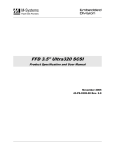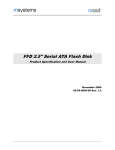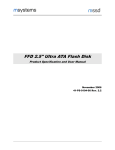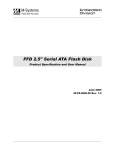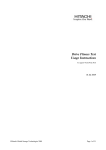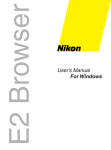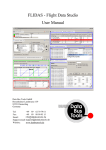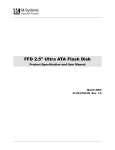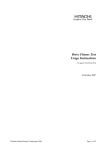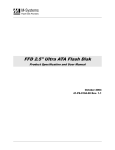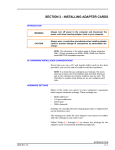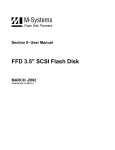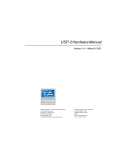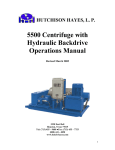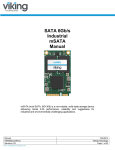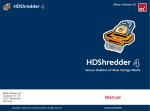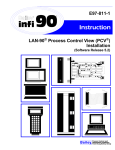Download Product Specification and User Manual - Digi-Key
Transcript
SSD (Formerly FFD) Ultra320 SCSI 3.5" Product Specification and User Manual August 2007 43-PS-0305-00 Rev. 2.2 SSD (Formerly FFD) Ultra320 SCSI 3.5" DOCUMENT CONTROL INFORMATION DCO No.: Title Name Date Issued by: Rugged Product Manager, Embedded Division Guy Freikorn January 31, 2006 Approved by: VP Marketing, Embedded Division Ofer Tsur January 31,2006 REVISION HISTORY Revision Date Description Reference 2.0 November 2005 Added information for new form factor, SSD Ultra320 SCSI 3.5” 68-pin Sections 4.1.7, 0, 4.1.10, 4.2, 4.4.4, 4.4.5, 8.1.12, 8.3, 11.5, 14, 16, 17 2.1 January 2006 Updated SSD Ultra320 SCSI 3.5” 68-pin outline drawing Section 4.1.10.4 Updated power requirements and consumption table Section 4.1.7 Updated memory capacities table Section 4.1.8 Updated weight table Updated reliability table Section 4.2 Updated MTBF table Section 4.2 Updated power consumption table Section 8.3 Updated supported SCSI command table 2.2 2 August 2007 Section 4.1.10.1 Section 5 Updated power consumption during Security Erase table Section 8.3 Updated ordering information Section 17 Changing to SanDisk document template General Remove the support in Fast-40 Section 4.1.1 Update Endurance section Section 4.1.9 Updated Security Erase Functionality Section 8.2 Updated Ordering Information to SanDisk SKU Section 17 Product Specification and User Manual 43-PS-0305-00 Rev. 2.2 SSD (Formerly FFD) Ultra320 SCSI 3.5" TABLE OF CONTENTS 1. Scope ..................................................................................................................................... 6 2. Applicable Documents ......................................................................................................... 6 3. Overview ................................................................................................................................ 7 4. Specifications ........................................................................................................................ 8 4.1. Characteristics................................................................................................................ 8 4.1.1. Supported SCSI Modes ................................................................................................... 8 4.1.2. Bus Characteristics .......................................................................................................... 8 4.1.3. Performance .................................................................................................................... 8 4.1.4. Access Time .................................................................................................................... 9 4.1.5. Start-Up Time................................................................................................................... 9 4.1.6. Seek Time and Latency Time .......................................................................................... 9 4.1.7. Power Requirements and Consumption ........................................................................ 10 4.1.8. Memory Densities .......................................................................................................... 10 4.1.9. Endurance...................................................................................................................... 12 4.1.10. Physical Characteristics................................................................................................. 12 4.1.11. Hot Insertion (Hot Swappable)....................................................................................... 18 4.2. Reliability ...................................................................................................................... 19 4.3. Embedded Error Detection and Error Correction Code (EDC/ECC) ............................ 19 4.4. Environmental Conditions ............................................................................................ 20 4.4.1. Temperature .................................................................................................................. 20 4.4.2. Altitude ........................................................................................................................... 20 4.4.3. Relative Humidity ........................................................................................................... 20 4.4.4. Shock ............................................................................................................................. 20 4.4.5. Vibration ......................................................................................................................... 20 4.5. Compliance with Standards.......................................................................................... 21 4.6. Access/Activity LED ..................................................................................................... 21 5. Supported SCSI Commands .............................................................................................. 22 6. SCSI Messages.................................................................................................................... 24 7. Packetized SCSI .................................................................................................................. 25 8. Vendor-Specific Commands .............................................................................................. 26 8.1. Security Erase Features ............................................................................................... 26 3 8.1.1. Full Security Erase Option ............................................................................................. 26 8.1.2. Partial Security Erase Option......................................................................................... 26 8.1.3. Resume Option .............................................................................................................. 27 8.1.4. Fill-Format Option .......................................................................................................... 27 Product Specification and User Manual 43-PS-0305-00 Rev. 2.2 SSD (Formerly FFD) Ultra320 SCSI 3.5" 8.1.5. Configuration.................................................................................................................. 27 8.1.6. Verifying Security Erase ................................................................................................ 35 8.1.7. Sanitizing Based on DoD 5220.22-M ............................................................................ 36 8.1.8. Sanitizing Based on NSA Manual 130-2 ....................................................................... 36 8.1.9. Sanitizing Based on USA Air Force AFSSI 5020 .......................................................... 37 8.1.10. Sanitizing (Purging) Based on USA Army Regulation 380-19....................................... 37 8.1.11. Sanitizing (Purging) Based on USA Navy NAVSO P-5239-26 ...................................... 38 8.1.12. Declassification Based on IRIG-106 (NTISSP-9) .......................................................... 38 8.2. Security Erase Functionality ......................................................................................... 41 8.3. Power Consumption during Security Erase.................................................................. 42 8.4. LED Indicator during Erase .......................................................................................... 42 9. Firmware Upgrade............................................................................................................... 43 10. Sense Key and Additional Sense Key Codes ................................................................... 44 11. Configuring and Installing the SSD 3.5” Ultra320 SCSI .................................................. 46 11.1. Package Contents ........................................................................................................ 46 11.2. Visual Inspection .......................................................................................................... 46 11.3. Handling Instructions .................................................................................................... 46 11.4. System Requirements .................................................................................................. 47 11.5. Configuring the SSD 3.5” Ultra320 SCSI ..................................................................... 47 11.5.1. SCSI ID Pins .................................................................................................................. 48 11.5.2. Termination Pins ............................................................................................................ 49 11.5.3. Forced Single-Ended Electrical Interface Pins .............................................................. 49 11.5.4. Write Protect Pins .......................................................................................................... 49 11.5.5. Secure Erase Pins ......................................................................................................... 49 11.5.6. Termination Power (TRMPWR) ..................................................................................... 50 11.5.7. LED Pins ........................................................................................................................ 50 11.5.8. 80-Pin Connector ........................................................................................................... 50 11.5.9. 68-Pin Connector ........................................................................................................... 50 11.6. Installing the SSD 3.5” Ultra320 SCSI.......................................................................... 52 11.6.1. Installing the SSD in a PC ............................................................................................. 52 11.6.2. Using the SSD in MS-DOS-Based Platforms ................................................................ 54 11.6.3. Using the SSD in Microsoft Windows-Based Platforms ................................................ 55 11.6.4. Using the SSD in Linux-Based Platforms ...................................................................... 55 11.6.5. Using the SSD in Unix-Based Platforms ....................................................................... 55 12. Troubleshooting .................................................................................................................. 57 12.1. Installing Your SCSI Host Adapter ............................................................................... 57 12.2. Termination Configuration ............................................................................................ 58 12.3. SCSI ID Configuration .................................................................................................. 58 4 Product Specification and User Manual 43-PS-0305-00 Rev. 2.2 SSD (Formerly FFD) Ultra320 SCSI 3.5" 12.4. Solving Installation Problems ....................................................................................... 58 13. Frequently Asked Questions (FAQs) about the SSD 3.5” Ultra320 SCSI ...................... 60 14. Label Information ................................................................................................................ 64 15. Built-In Test (BIT) ................................................................................................................ 66 16. Factory Default Setup ......................................................................................................... 67 17. Ordering Information .......................................................................................................... 68 A. Old-Structure Vendor-Specific Security Erase SCSI Command ..................................... 69 How to Contact Us .................................................................................................................... 70 5 Product Specification and User Manual 43-PS-0305-00 Rev. 2.2 SSD (Formerly FFD) Ultra320 SCSI 3.5" 1. SCOPE This specification and user manual defines the performance, design and acceptance requirements of the SSD (formerly FFD) 3.5” Ultra320 SCSI flash disk. It also provides instructions for installing and configuring the SSD Ultra320 SCSI 3.5” flash disk. Throughout this manual, the SSD Ultra320 SCSI 3.5” flash disk will be referred to as SSD. 2. APPLICABLE DOCUMENTS ANSI X3.131-1994 American National Standard for Information Systems - Small Computer System Interface-2 (SCSI-2). ANSI X3T9.2/85-82 American National Standard for Information Systems - Common Command Set (CCS) of the Small Computer System Interface (SCSI). ANSI INCITS 362-2002, - SCSI Parallel Interface-4 (SPI-4). ANSI X3.301-1997 American National Standard Institute Information Technology - SCSI-3 Primary Commands (SPC) ANSI NCITS 306-1998 American National Standard Institute Information Technology SCSI-3 Block Commands (SBC) In addition, the ANSI X3.270-1996 and ANSI NCITS 336-2000 documents are applicable. 6 Product Specification and User Manual 43-PS-0305-00 Rev. 2.2 SSD (Formerly FFD) Ultra320 SCSI 3.5" 3. OVERVIEW The SSD is a non-volatile mass memory storage unit equipped with a SCSI interface, and containing the following subassemblies: CPU SCSI interface controller Flash memory array The SSD dimensions enabling mounting in a standard 3.5” disk drive enclosure. Figure 1 illustrates the SSD block diagram. Figure 1: SSD Ultra320 SCSI 3.5” Block Diagram The SSD interface complies with the SCSI-2 and SCSI-3, and supports the Common Command Set (CCS). Refer to Section 5, Table 13 for a list of supported SCSI commands. The SSD supports both Single-Ended (SE) and Low Voltage Differential (LVD) electrical interfaces, with 68-pin and 80-pin connector. Refer to Section 4.1.10.3 for specific connector interface details. 7 Product Specification and User Manual 43-PS-0305-00 Rev. 2.2 SSD (Formerly FFD) Ultra320 SCSI 3.5" 4. SPECIFICATIONS 4.1. Characteristics 4.1.1. Supported SCSI Modes The SSD supports the following SCSI modes: Asynchronous mode DT/PT modes o Wide PT Fast-160 (Ultra320 – 320 MB/sec) o Wide DT Fast-80 (Ultra160 – 160 MB/sec) o Wide DT Fast-20 (40 MB/sec) o Wide DT Fast-10 (20 MB/sec) ST modes o Fast-20 (40 MB/sec) o Fast-10 (20 MB/sec) o Fast-5 (10 MB/sec) 4.1.2. Bus Characteristics The SSD has 16-bit bus type (wide), LVD and SE modes. 4.1.3. Performance Performance testing was carried out using the following setup: Bus type: 16-bit (wide) SCSI transfer mode: Ultra320 (320 MB/sec) OS: DOS and Windows XP Transfer size > 1MB Benchmark utility: IOMeter (release 12/2003) The SSD meets the performance requirements, as specified in Table 1. Table 1: SSD Ultra320 SCSI 3.5” Transfer Rates and IOPS 8 Operation Burst Rate (MB/Sec) Sustained Rate 1MB Blocks (MB/sec) Read 320 40 Write 320 40 Product Specification and User Manual 43-PS-0305-00 Rev. 2.2 SSD (Formerly FFD) Ultra320 SCSI 3.5" 4.1.4. Access Time Maximum access time is < 0.8 msec (80 µsec). 4.1.5. Start-Up Time The required period for the SSD to mount the media and respond to media-related commands (read, write, verify) depends on the media density (Table 2). Table 2: SSD Ultra320 SCSI 3.5” Mount Times Density (GB) Time to Mount Media (Seconds, after Low-Level Format) 2 2 16 17 32 28 64 57 128 116 176 160 352 315 During the start-up process, all SCSI commands involving media access return the following status conditions: CHECK CONDITION, sense key NOT READY and Extended sense key LOGICAL UNIT IN PROCESS OF BECOMING READY. SSD supports the Start Stop Unit command, which is commonly used by the host to await the completion of the start-up process. 4.1.6. Seek Time and Latency Time The SSD has no seek time and Latency time. 9 Product Specification and User Manual 43-PS-0305-00 Rev. 2.2 SSD (Formerly FFD) Ultra320 SCSI 3.5" 4.1.7. Power Requirements and Consumption The specifications listed in Table 3 apply to all operational modes (except Secure Erase) while Termination Power (TERMPWR) is set to OFF. The SSD input voltage is +5VDC, with a tolerance of 0.5V. Table 3 describes the power consumption based on density and disk type (80-pin connector). Table 3: SSD Ultra320 SCSI 3.5” Power Consumption (Typical) Disk Type Disk Density (GB) Idle Mode Read/Write Mode 16 0.6 A/3.0 W 0.9 A/4.5 W 32 1.1 A/5.5 W 1.3 A/6.5 W 128 1.2 A/6.0 W 1.4 A/7.0 W 224 1.2 A/6.0 W 1.4 A/7.0 W 320 1.3 A/6.5 W 1.5 A/7.5 W 352 1.3 A/6.5 W 1.6 A/8.0 W Note: The information in this section is relevant for SSD units with firmware version 1.07 and later. 4.1.8. Memory Densities Table 4 describes the available densities for the SSD. Table 4: SSD Ultra320 SCSI 3.5” Available Densities 10 Unformatted Disk Density (GB)1 Formatted Disk Density (No. of Blocks) Cylinders Heads Sectors (Blocks) Bytes/ Block 1 2023424 1976 16 64 512 2 4079616 3984 16 64 512 4 7991296 7804 16 64 512 8 16044032 15668 16 64 512 12 24096768 23532 16 64 512 16 32149504 31396 16 64 512 20 40202240 39260 16 64 512 24 48254976 47124 16 64 512 32 64360448 62852 16 64 512 40 80465920 78580 16 64 512 48 96571392 94308 16 64 512 56 112680960 110040 16 64 512 64 128786432 125768 16 64 512 72 144891904 141496 16 64 512 Product Specification and User Manual 43-PS-0305-00 Rev. 2.2 SSD (Formerly FFD) Ultra320 SCSI 3.5" Unformatted Disk Density (GB)1 Formatted Disk Density (No. of Blocks) Cylinders Heads Sectors (Blocks) Bytes/ Block 80 160997376 157224 16 64 512 96 193208320 188680 16 64 512 104 209317888 204412 16 64 512 112 225423360 220140 16 64 512 120 241528832 235868 16 64 512 128 257634304 251596 16 64 512 136 273739776 267324 16 64 512 144 289845248 283052 16 64 512 152 305954816 298784 16 64 512 160 322060288 314512 16 64 512 176 354271232 345968 16 64 512 192 386482176 377424 16 64 512 208 418697216 408884 16 64 512 224 450908160 440340 16 64 512 240 483119104 471796 16 64 512 256 515334144 503256 16 64 512 272 547545088 534712 16 64 512 288 579756032 566168 16 64 512 304 611971072 597628 16 64 512 320 644182016 629084 16 64 512 336 676392960 660540 16 64 512 352 708608000 692000 16 64 512 Notes: 1. Memory density is specified when placing device orders. 2. The information in this section is relevant for SSD units with firmware version 1.07 and later. 11 Product Specification and User Manual 43-PS-0305-00 Rev. 2.2 SSD (Formerly FFD) Ultra320 SCSI 3.5" 4.1.9. Endurance The SSD product life span and the performance are enhanced by the following features: Dynamic wear-leveling algorithm: This algorithm eliminates situations where the application repeatedly writes to the same physical location until its flash components wear out. The dynamic wear leveling algorithm applies virtual mapping of logical sectors to physical blocks and is completely transparent to the customer application. Garbage collection process: This process eliminates the need to perform an erase operation prior to every write operation, which eliminates excessive disk deterioration. Additionally, the garbage collection process accumulates data considered necessary for erasure until the block is full. EDC/ECC (Error Detection Code/Error Correction Code): The SSD has embedded error detection and error correction hardware and software mechanisms. The EDC/ECC uses the BCH algorithm, which can detect up to 5 errors in 512 bytes of data, and correct up to 4 errors. Bad-block mapping algorithm: This algorithm replaces bad blocks with new blocks from available spares. 4.1.10. Physical Characteristics 4.1.10.1 Weight The weight of the SSD conforms to the values defined in Table 5. Table 5: SSD Ultra320 SCSI 3.5” Weight Memory Density (GB) Case Height (in) Maximum Weight (g) 1 – 8, 16, 24, 32 0.5 250 12, 20, 40 – 128 0.5 275 136 – 224 1 415 240 – 320 1 480 336 – 352 1 525 Note: The information in this section is relevant for SSD units with firmware version 1.07 and later. 12 Product Specification and User Manual 43-PS-0305-00 Rev. 2.2 SSD (Formerly FFD) Ultra320 SCSI 3.5" 4.1.10.2 Dimensions Table 6 contains the nominal dimensions of the SSD. Refer to Figure 2 for detailed mounting configuration dimensions. Table 6: SSD 80-pin Nominal Dimensions Height Width Depth 0.5 in 4.00 in 5.75 in 12.70 mm 101.60 mm 146.05 mm Table 7: SSD 68-pin Nominal Dimensions Height Width Depth 0.5 in 4.00 in 5.75 in 12.70 mm 101.60 mm 146.10 mm Note: For densities higher than 128GB, the SSD is supplied in a 1” (25.4 mm) high raised casing. Figure 2: SSD Ultra320 SCSI 3.5” 80-Pin Assembly (in Inches) 13 Product Specification and User Manual 43-PS-0305-00 Rev. 2.2 SSD (Formerly FFD) Ultra320 SCSI 3.5" Figure 3: SSD Ultra320 SCSI 3.5” 68-Pin Assembly (in Inches) 4.1.10.3 80-Pin Connector Interface The SSD 80-pin connector interface pinouts are described in Table 8 and Table 9, according to the electrical interface being used. Table 8: 80-Pin Connector Pinout with Single-Ended (SE) Electrical Interface Pin Number 1 2 3 4 5 6 7 8 9 10 11 12 13 14 Signal Name RESERVED RESERVED RESERVED RESERVED RESERVED RESERVED -DB(11) -DB(10) -DB(9) -DB(8) -I/O -REQ -C/D Pin Number 41 42 43 44 45 46 47 48 49 50 51 52 53 Product Specification and User Manual Signal Name GROUND GROUND GROUND MATED 1 RESERVED GROUND GROUND GROUND GROUND GROUND GROUND GROUND GROUND 43-PS-0305-00 Rev. 2.2 SSD (Formerly FFD) Ultra320 SCSI 3.5" Pin Number 14 15 16 17 18 19 20 21 22 23 24 25 26 27 28 29 30 31 32 33 34 35 36 37 38 39 40 Signal Name -SEL -MSG -RST -ACK -BSY -ATN -DBP(0) -DB(7) -DB(6) -DB(5) -DB(4) -DB(3) -DB(2) -DB(1) -DB(0) -DBP(1) -DB(15) -DB(14) -DB(13) -DB(12) 5VDC 5VDC 5VDC RESERVED RESERVED SCSI ID (0) SCSI ID (2) Pin Number 54 55 56 57 58 59 60 61 62 63 64 65 66 67 68 69 70 71 72 73 74 75 76 77 78 79 80 Signal Name GROUND GROUND GROUND GROUND GROUND GROUND GROUND GROUND GROUND GROUND GROUND GROUND GROUND GROUND GROUND GROUND GROUND GROUND GROUND GROUND MATED 2 GROUND GROUND ACTIVE LED RESERVED SCSI ID (1) SCSI ID (3) Table 9: 80-Pin Connector Pinout with Low Voltage Differential (LVD) Electrical Interface 15 Pin Number Signal Name Pin Number Signal Name 1 RESERVED 41 GROUND 2 RESERVED 42 GROUND 3 RESERVED 43 GROUND 4 RESERVED 44 MATED 1 5 RESERVED 45 RESERVED 6 RESERVED 46 DIFFSENS 7 -DB(11) 47 +DB(11) 8 -DB(10) 48 +DB(10) 9 -DB(9) 49 +DB(9) 10 -DB(8) 50 +DB(8) Product Specification and User Manual 43-PS-0305-00 Rev. 2.2 SSD (Formerly FFD) Ultra320 SCSI 3.5" Pin Number Signal Name Pin Number Signal Name 11 -I/O 51 +I/O 12 -REQ 52 +REQ 13 -C/D 53 +C/D 14 -SEL 54 +SEL 15 -MSG 55 +MSG 16 -RST 56 +RST 17 -ACK 57 +ACK 18 -BSY 58 +BSY 19 -ATN 59 +ATN 20 -DBP(0) 60 +DBP(0) 21 -DB(7) 61 +DB(7) 22 -DB(6) 62 +DB(6) 23 -DB(5) 63 +DB(5) 24 -DB(4) 64 +DB(4) 25 -DB(3) 65 +DB(3) 26 -DB(2) 66 +DB(2) 27 -DB(1) 67 +DB(1) 28 -DB(0) 68 +DB(0) 29 -DBP(1) 69 +DBP(1) 30 -DB(15) 70 +DB(15) 31 -DB(14) 71 +DB(14) 32 -DB(13) 72 +DB(13) 33 -DB(12) 73 +DB(12) 34 5VDC 74 MATED 2 35 5VDC 75 GROUND 36 5VDC 76 GROUND 37 RESERVED 77 ACTIVE LED 38 RESERVED 78 RESERVED 39 SCSI ID (0) 79 SCSI ID (1) 40 SCSI ID (2) 80 SCSI ID (3) Notes: 1. The 12V pins, as defined in the SCA specification (pins 1-4 on the 80-pin connector), are not required for SSD operation. These pins may be connected to a 12V power supply or left unconnected. 2. The activity LED is limited to 24 mA and a 100 Ω resistor. 16 Product Specification and User Manual 43-PS-0305-00 Rev. 2.2 SSD (Formerly FFD) Ultra320 SCSI 3.5" 4.1.10.4 68-Pin Connector Interface The SSD 68-pin connector interface pinouts are described in Table 10 and Table 11, according to the electrical interface being used. Table 10: Pinout for SSD 68-Pin Connector with Single-Ended Electrical Interface Pin Number 1 2 3 4 5 6 7 8 9 10 11 12 13 14 15 16 17 18 19 20 21 22 23 24 25 26 27 28 29 30 31 32 33 34 Signal Name GROUND GROUND GROUND GROUND GROUND GROUND GROUND GROUND GROUND GROUND GROUND GROUND GROUND GROUND GROUND GROUND TERMPWR TERMPWR RESERVED GROUND GROUND GROUND GROUND GROUND GROUND GROUND GROUND GROUND GROUND GROUND GROUND GROUND GROUND GROUND Pin Number 35 36 37 38 39 40 41 42 43 44 45 46 47 48 49 50 51 52 53 54 55 56 57 58 59 60 61 62 63 64 65 66 67 68 Signal Name -DB(12) -DB(13) -DB(14) -DB(15) -DBP(1) -DB(0) -DB(1) -DB(2) -DB(3) -DB(4) -DB(5) -DB(6) -DB(7) -DBP(0) GROUND GROUND TERMPWR TERMPWR RESERVED GROUND -ATN GROUND -BSY -ACK -RST -MSG -SEL -C/D -REQ -I/O -DB(8) -DB(9) -DB(10) -DB(11) Table 11: Pinout for SSD 68-Pin Connector with Low Voltage Differential Electrical Interface 17 Product Specification and User Manual 43-PS-0305-00 Rev. 2.2 SSD (Formerly FFD) Ultra320 SCSI 3.5" Pin Number Signal Name Pin Number Signal Name 1 +DB(12) 35 -DB(12) 2 +DB(13) 36 -DB(13) 3 +DB(14) 37 -DB(14) 4 +DB(15) 38 -DB(15) 5 +DBP(1) 39 -DBP(1) 6 +DB(0) 40 -DB(0) 7 +DB(1) 41 -DB(1) 8 +DB(2) 42 -DB(2) 9 +DB(3) 43 -DB(3) 10 +DB(4) 44 -DB(4) 11 +DB(5) 45 -DB(5) 12 +DB(6) 46 -DB(6) 13 +DB(7) 47 -DB(7) 14 +DBP(0) 48 -DBP(0) 15 GROUND 49 GROUND 16 DIFFSENS 50 GROUND 17 TERMPWR 51 TERMPWR 18 TERMPWR 52 TERMPWR 19 RESERVED 53 RESERVED 20 GROUND 54 GROUND 21 +ATN 55 -ATN 22 GROUND 56 GROUND 23 +BSY 57 -BSY 24 +ACK 58 -ACK 25 +RST 59 -RST 26 +MSG 60 -MSG 27 +SEL 61 -SEL 28 +C/D 62 -C/D 29 +REQ 63 -REQ 30 +I/O 64 -I/O 31 +DB(8) 65 -DB(8) 32 +DB(9) 66 -DB(9) 33 +DB(10) 67 -DB(10) 34 +DB(11) 68 -DB(11) 4.1.11. Hot Insertion (Hot Swappable) The following classes of hot insertion are supported by the 80-pin SSD (in accordance with the SCSI controller data sheet): 18 Product Specification and User Manual 43-PS-0305-00 Rev. 2.2 SSD (Formerly FFD) Ultra320 SCSI 3.5" Class 1: Power off during removal or insertion. Class 2: RST signal asserted continuously during removal or insertion. Class 3: Current I/O processes not permitted during insertion or removal. 4.2. Reliability The SSD provides a very high number of hours for Mean Time Between Failures (MTBF). Exact times are density dependent, as described in Table 12. Table 12: Mean Time Between Failures (MTBF) per Density Density (GB) Mean Time Between Failures (Hours) 1 – 8, 16 833,820 64 473,507 128 315,667 160 259,222 224 203,513 256 178,460 320 150,161 352 136,067 Performance assessments are based on Telcordia SR-332, GB, 25°C. A detailed MTBF report can be provided upon customer request. Note: The information in this section is relevant for SSD units with firmware version 1.07 and later. 4.3. Embedded Error Detection and Error Correction Code (EDC/ECC) The SSD has embedded error detection and error correction hardware and software mechanisms. The EDC/ECC uses the BCH algorithm, which can detect up to 5 errors in 512 bytes of data, and correct up to 4 errors. 19 Product Specification and User Manual 43-PS-0305-00 Rev. 2.2 SSD (Formerly FFD) Ultra320 SCSI 3.5" 4.4. Environmental Conditions The SSD complies with the performance requirements specified herein after exposure to non-operating environmental conditions, or during and after exposure to operating environmental conditions. 4.4.1. Temperature The SSD operates without degradation at 1 atmosphere in the following air temperature ranges: Commercial temperature version: 0C to +70C Enhanced temperature version: -25C to +75C Extended temperature version: -40C to +85C The SSD meets the performance requirements specified herein after withstanding exposure to a nominal ambient temperature of –40C for not less than 3 days, and of +85C for a period of not less than 6 hours. Storage temperature range: -55C to +95C 4.4.2. Altitude The SSD operates at altitudes ranging from sea level to 80,000 ft, and withstands air transportation in non-pressurized flights at altitudes of up to 80,000 ft. 4.4.3. Relative Humidity The SSD can withstand 5% to 95% non-condensing relative humidity. 4.4.4. Shock The SSD operates as specified after being subjected to shock testing under the following conditions: 50 G half-sine pulses for 11 ms and 1,500 G half-sine pulses for 0.5 ms Shock testing was performed according to the MIL-STD-810F standard. A detailed testing report is available for download from the SanDisk website. 4.4.5. Vibration The SSD operates as specified without degradation when subjected to the following vibration conditions: 16.3G RMS (random, 20 Hz to 2000 Hz, 3 axes of vibration) Vibration testing was performed according to the MIL-STD-810F standard. A detailed testing report is available for download from the SanDisk website. 20 Product Specification and User Manual 43-PS-0305-00 Rev. 2.2 SSD (Formerly FFD) Ultra320 SCSI 3.5" 4.5. Compliance with Standards The SSD is guaranteed to comply with CE, UL and FCC Class B (EMI/EMC) standards as follows: CE, UL, EN 55022 Class B, CISPR 22 Class B, AS/NZS 3548 Class B, BSMI CNS 13438 Class B, CAN/CSA-V-3/2001.04 (VCCI), FCC Part 15 Class B, EN 61000-3-2, EN 61000-3-3, IEC 61000-4-2/3/4/5/6/8/11, MIL-STD-810F. Figure 4: Logos of Applicable Standards 4.6. Access/Activity LED SSD has a green access/activity LED on the front of the unit. The LED lights during power-up, diagnostic operations, and whenever the disk is performing commands. 21 Product Specification and User Manual 43-PS-0305-00 Rev. 2.2 SSD (Formerly FFD) Ultra320 SCSI 3.5" 5. SUPPORTED SCSI COMMANDS The SSD supports the SCSI commands listed in Table 13. Table 13: SCSI Commands Option1 Command Code M 0x00 REZERO UNIT O 2 0x01 REQUEST SENSE M 0x03 FORMAT UNIT M 0x04 REASSIGN BLOCKS O 0x07 READ(6) M 0x08 WRITE(6) O 0x0A SEEK(6) O 1 0x0B INQUIRY M 0x12 MODE SELECT(6) O 0x15 Command Group 0: 6-Byte Commands TEST UNIT READY RESERVE(6) 3 M 0x16 RELEASE(6) M 0x17 MODE SENSE(6) O 0x1A START/STOP UNIT O 0x1B SEND DIAGNOSTICS M 0x1D READ CAPACITY M 0x25 READ(10) M 0x28 WRITE(10) O 0x2A SEEK(10) O 0x2B WRITE AND VERIFY(10) O 0x2E VERIFY(10) O 0x2F READ DEFECT DATA(10) O 0x37 SYNCHRONIZE CACHE (10) O 0x35 WRITE BUFFER O 0x3B CHANGE DEFINITION O 0x40 MODE SELECT(10) O 0x55 MODE SENSE(10) O 0x5A O 0xA0 Groups 1 and 2: 10-Byte Commands Groups 5: 12-Byte Commands REPORT LUNS 22 Product Specification and User Manual 43-PS-0305-00 Rev. 2.2 SSD (Formerly FFD) Ultra320 SCSI 3.5" Command Option1 Command Code V 0xDF V 0xFF Vendor-Specific: 6-Byte Commands SECURE ERASE Vendor-Specific: 10-Byte Commands SANITIZE NEW FORMAT 23 1. M =Mandatory O = Optional V = Vendor Specific 2. REZERO UNIT and SEEK(6) are obsolete in SCSI-3, but are supported by the SSD for compatibility with SCSI-2. 3. In SCSI-3 fields 3rd Party and 3rd Party Device ID are obsolete in RESERVE(6) and RESERVE(6) commands, but are supported by the SSD for compatibility with SCSI-2. Product Specification and User Manual 43-PS-0305-00 Rev. 2.2 SSD (Formerly FFD) Ultra320 SCSI 3.5" 6. SCSI MESSAGES The SSD indicates its ability to respond to SCSI messages by responding to the ATN signal with a change to the MESSAGE OUT phase. Table 14 describes the supported SCSI messages. Table 14: SCSI Message Codes Code Direction (Relative to the Initiator) COMMAND COMPLETE 0h In ABORT TASK SET 6h Out INITIATOR DETECTED ERROR 5h Out MESSAGE PARITY ERROR 9h Out MESSAGE REJECT 7h In/Out NO OPERATION 8h Out BUS DEVICE RESET 0Ch Out ABORT TASK 0Dh Out CLEAR TASK SET 0Eh Out IGNORE WIDE RESIDUE 23h Out 80h - FFh Out SYNCHRONOUS DATA TRANSFER REQUEST 01h (extended) In/Out WIDE DATA TRANSFER REQUEST 01h (extended) In/Out PARALLEL PROTOCOL REQUEST 01h (extended) In/Out Status IDENTIFY 24 Product Specification and User Manual 43-PS-0305-00 Rev. 2.2 SSD (Formerly FFD) Ultra320 SCSI 3.5" 7. PACKETIZED SCSI The SSD supports the Packetized SCSI protocol, as described in the SPI-4 standard (supports all the necessary information units). The SPI-4 standard outlines the following new features: Paced data transfer: Packetized SCSI Free-running clock (ACK, REQ, and P1 for valid data) ISI (Intersymbol Interference) Compensation: Precomp drivers and Adaptive Active Filter receivers Skew compensation Training pattern for Adaptive Active Filters and skew compensation 25 Product Specification and User Manual 43-PS-0305-00 Rev. 2.2 SSD (Formerly FFD) Ultra320 SCSI 3.5" 8. VENDOR-SPECIFIC COMMANDS 8.1. Security Erase Features The vendor-specific Security Erase feature quickly erases all selected media on the SSD. The SCSI vendor-specific (command codes 0xDFh and 0xFFh) or the vendor-specific Security Erase hardware interrupt (offered as an option upon customer request) activates this function. When the Security Erase function is activated, all NAND flash (for Full Security Erase, as described in Section 8.1.1), or part of the NAND flash components (for Partial Security Erase, as described in Section 8.1.2) are erased. The SSD Secure Erase option can also be configured to fill the erased part of the media immediately after the erase process is complete. Bad blocks and unused flash storage are erased as well. 8.1.1. Full Security Erase Option When the Full Security Erase function is activated, all NAND flash components are erased. To make the SSD fully operational after the completion of the Full Security Erase process, the SSD must be power cycled. This function is identical to the previously available feature in the SSD product line. 8.1.2. Partial Security Erase Option When a Partial Security Erase is initiated, only selected parts of the media are erased. The unselected parts of the media remain intact. The SSD must be power cycled to become fully operational after the completion of the Partial Security Erase process. Since it is not possible to perform a low-level format on only part of the media, it is strongly recommended to use the Fill-Format option, as described in Section 8.2. Users can define up to eight areas/partitions on the SSD media. Each area has the following attributes: Partition number (0 - 7). A To Be Erased flag (0 = Do not erase this partition, 1 = Erase this partition). Start and End sector boundaries (boundaries included). When the Partial Security Erase feature is activated via the vendor-specific security erase hardware interrupt and the partial Security Erase is set to ON, only those partitions with the To Be Erased flag set to 1 are erased. When the Partial Security Erase feature is activated via the SCSI vendor-specific command, the user may select whether to erase the designated partitions, or whether to override the designated parameters and set different partitions to be erased. When a sector resides in overlapping partitions where one partition is set to be erased and one is set to remain intact, the partition plus the part of the sector that overlaps will be erased. 26 Product Specification and User Manual 43-PS-0305-00 Rev. 2.2 SSD (Formerly FFD) Ultra320 SCSI 3.5" 8.1.3. Resume Option If the power is interrupted while Security Erase is in process, part of the media may remain intact. The SSD provides a Resume option that restarts Security Erase on the next power up. The Resume option persists until the security erase is complete. The Resume option is user configurable. This feature default is on. 8.1.4. Fill-Format Option The Fill-Format option automatically writes the erased media. This process can replace the lowlevel format process, and is strongly recommended after the Partial Security Erase because it is the only way to perform a partial low-level format of the media. The Fill-Format option should not replace the low-level format process if a quick-sanitizing process is used. Erasing the media without either the fill-format option or low-level formatting will result in a longer mount time. 8.1.5. Configuration 8.1.5.1 Configurable Parameters The following parameters can be configured: Disable/Enable Resume Security Erase: If this flag is disabled and power is interrupted while Security Erase is in progress, the SSD will not restart Security Erase on the next power up. This flag is enabled by default. Disable/Enable Partial Security Erase: If this flag is enabled, Partial Secure Erase is activated and only the designated partitions are erased during the Security Erase process. If this flag is disabled (default) all media is erased. When activating Security Erase via the SCSI vendor-specific command, the user may override this flag. Fill-Format Media: Select if and how to fill-format the erased media after Security Erase. If the Fill-Format option is OFF, the user must low-level format the SSD after Security Erase. The fill options are as follows: o Fill = 1: No fill (default) o Fill = 2: Fill with zeros o Fill = 3: Fill with random pattern Partition configuration: Up to eight partitions may be set. Each partition contains the following information: <Partition number (0-7) > <Partition on/off (0/1)> <Start Sector> <End Sector> 27 Product Specification and User Manual 43-PS-0305-00 Rev. 2.2 SSD (Formerly FFD) Ultra320 SCSI 3.5" 8.1.5.2 Configuring with Standard SCSI WRITE BUFFER Commands All Security Erase parameters are configured via the SCSI WRITE BUFFER command. Table 15: Disable/Enable Resume Security Erase (on Power-Up) Bit Byte 7 6 5 4 2 1 0 Operation Code = 0x3B 0 Logical Unit Number 1 Reserved Mode = 0x01 Reserved (0x00) 2 3 3 MSB Buffer Offset = 0x0B 4 LSB 5 6 MSB Parameter List Length = 0x01 7 LSB 8 Control 9 For example, the SCSI commands for enabling/disabling the resume option are: 3b 01 00 00 00 0b 00 00 01 00 The disable/enable resume security erase data structure to be transferred contains one byte, as described in Table 16. Table 16: Disable/Enable Resume Security Erase Data Structure Bit Byte 7 6 5 4 3 2 1 Reserved 0 0 Resume A Resume bit of 1 enables resuming Security Erase on power-up. A Resume bit of 0 disables the resume option on power-up (see Section 8.1.5.1). Table 17: Disable/Enable Partial Security Erase Bit Byte 7 6 5 Logical Unit Number 1 Reserved 1 0 Mode = 0x01 MSB Buffer Offset = 0x14 LSB 5 28 2 Reserved (0x00) 2 4 3 Operation Code = 0x3B 0 3 4 Product Specification and User Manual 43-PS-0305-00 Rev. 2.2 SSD (Formerly FFD) Ultra320 SCSI 3.5" Bit Byte 6 7 6 5 4 3 2 1 0 MSB Parameter List Length = 0x01 7 LSB 8 Control 9 For example, the SCSI commands for enabling/disabling Partial Security Erase are: 3b 01 00 00 00 14 00 00 01 00 The disable/enable Partial Security Erase data structure to be transferred contains one byte, as described in Table 18. Table 18: Disable/Enable Partial Security Erase Data Structure Bit Byte 7 6 5 4 3 2 1 Reserved 0 0 Partial A Partial bit of 1 enables partial security erase on power-up. A Partial bit of 0 disables partial security erase on power-up. Table 19: Setting the Boundaries Bit Byte 7 6 5 3 Logical Unit Number 1 1 0 Reserved Mode = 0x1 Reserved (0x00) 2 MSB Buffer Offset = 0x13 4 LSB 5 6 2 Operation Code = 0x3B 0 3 4 MSB Parameter List Length 7 LSB 8 Control 9 Bit Description Operation Code: 3Bh Mode 0x1: Vendor-specific mode Buffer Offset: 0x13. 29 Product Specification and User Manual 43-PS-0305-00 Rev. 2.2 SSD (Formerly FFD) Ultra320 SCSI 3.5" Parameter List Length: Specifies the length of the transfer. Each partition requires 12 bytes in the data structure to be transferred: o 2 bytes for the partition number o 2 bytes to indicate whether Security Erase has been set for this partition (1 = ERASE ON) o 4 bytes for the start sector of the partition (hexadecimal number) o 4 bytes for the end sector of the partition (hexadecimal number) Table 20: Partition Structure Bit Byte 7 6 5 4 3 2 1 0 Partition number 1 Reserved 2 5 To Be Erased Reserved 3 4 0 MSB Start Sector 6 7 LSB 8 MSB 9 10 11 End Sector LSB For example, to set partition 0 from sector 0 to sector 16383 (0x3FFF) to remain intact and partition 1 from sector 16384 (0x4000) to sector 32767 (0x7FFF) to be erased, the SCSI command is: 3b 01 00 00 00 13 00 00 18 00 The data structure to be transferred for the above configuration is illustrated in Figure 5. 00 00 00 00 00 00 00 00 00 00 3F FF 00 01 00 01 00 00 40 00 00 00 7F FF Figure 5: Example Data Structure 30 Product Specification and User Manual 43-PS-0305-00 Rev. 2.2 SSD (Formerly FFD) Ultra320 SCSI 3.5" 8.1.5.3 Reading Security Erase Parameters Table 21 describes the configuration for reading the boundaries of the Security Erase parameters. Table 21: Reading the Boundaries Bit Byte 7 6 5 4 2 1 0 Operation Code = 0x3C 0 Logical Unit Number 1 Reserved Mode = 0x1 Reserved (0x00) 2 3 3 MSB Buffer Offset = 0x13 4 LSB 5 6 MSB Allocation length 7 LSB 8 Control 9 Bit Description Operation Code: 3Ch Mode 0x1: Vendor-specific mode Buffer Offset: 0x13 Allocation length: Specifies the length of the transfer. Each partition requires 12 bytes. The first four bytes of the received data contain the read length, therefore the transfer length is (NUMBER_OF_PARTITIONS_TO_READ x 12) + 4 The first four bytes of the data structure to be received indicate the length of the received data. All following bytes are the partition information. For example, to read all the data, the user should enter 100 (64 HEX) as the allocation length (12 × 8 + 4). The SCSI command is: 3C 01 00 00 00 13 00 00 64 00 31 Product Specification and User Manual 43-PS-0305-00 Rev. 2.2 SSD (Formerly FFD) Ultra320 SCSI 3.5" The data structure received for the entire security erase partition information is illustrated in Figure 6. 00 00 00 60 00 00 00 00 00 00 00 00 00 00 00 00 00 01 00 00 00 00 00 00 00 00 00 00 00 02 00 00 00 00 00 00 00 00 00 00 00 03 00 00 00 00 00 00 00 00 00 00 00 04 00 00 00 00 00 00 00 00 00 00 00 05 00 00 00 00 00 00 00 00 00 00 00 06 00 00 00 00 00 00 00 00 00 00 00 07 00 00 00 00 00 00 00 00 00 00 Figure 6: Data Structure for Reading 0x64 Bytes 8.1.5.4 Sanitize Configuration Commands Table 22: Sanitize Configuration Commands Bit Byte 7 6 5 3 2 1 0 Operation Code = 0x3C 0 Logical Unit Number 1 Reserved Mode = 0x1 Reserved (0x00) 2 3 4 MSB Buffer Offset = 0x23 4 LSB 5 6 MSB 0x05 7 LSB 8 Control 9 8.1.5.5 Data Length is 5 Bytes Table 23: Data Length is 5 Bytes Bit Byte 32 7 6 5 4 3 0 Master Command 1 Parameter 1 2 Parameter 2 3 Parameter 3 4 IRIG Product Specification and User Manual 2 1 0 43-PS-0305-00 Rev. 2.2 SSD (Formerly FFD) Ultra320 SCSI 3.5" 8.1.5.6 Vendor-Specific Security Erase SCSI Command The vendor-specific SCSI command can be used to bypass the default Security Erase parameters that are defined in the security erase configuration. There are two commands that perform security erase/sanitize: 0xDF (an old method included for backward compatibility with old products) and the more flexible 0x4F, which is strongly recommended. Table 24: Security Erase Command, New Structure Bit Byte 7 6 5 4 3 2 1 0 Operation Code = 0x4F 0 LUN 1 SubCode 2 Parameter 3 3 Parameter 2 4 Parameter1 5 Master Command 6 Reserved 7 Reserved 8 Erase Mask 9 Control Sub-codes: 0x0A: Perform Sanitize 0x0B: Perform Sanitize and maintain the bad block data in accordance with IRIG106 The Sanitize command provides a high degree of flexibility, which enables executing declassification procedures defined in various standards by providing different arguments to the command. Specifically, the Sanitize command enables defining up to three stages of the declassification process, where each stage can be either erasing the media and overwriting it with a given character, or erasing the media and filling it with random information a specified number of times. If the number of erase-fill cycles is 0, the Sanitize command performs a complete erase but does not fill the media. This is the fastest option; and is also known as the Security Erase option. The default Sanitize procedure is factory-preset to the Security Erase option (erase the media without media fill). The Master Command has the following layout: 33 Bits 6-7: Sub-command selection o Value of 00b: Execute default Sanitize procedure o Value of 01b: Execute 1 sub-command, defined in bits 0-1 Product Specification and User Manual 43-PS-0305-00 Rev. 2.2 SSD (Formerly FFD) Ultra320 SCSI 3.5" o Value of 10b: Execute 2 sub-commands, defined in bits 0-1 and 2-3 o Value of 11b: Execute 3 sub-commands, defined in bits 0-1, 2-3, and 4-5 When the Master Command specifies only 1 or 2 sub-commands, parameters for the remaining sub-commands are reserved and should be set to 0 for compatibility with future versions. For the default Sanitize procedure, all other bits in the Master Command and parameters 1-3 are reserved and should be set to 0 for compatibility with future versions. Bits 0-1, 2-3, and 4-5 of the Master Command contain the following sub-commands: Value of 0: Erase and fill with given character. The character is provided in the corresponding parameter. Value of 1: Erase and fill with random data, several times. The number of erase/fill loops is provided in the corresponding parameter. Zero number of loops means erase once and do not fill. Only the 7 least significant bits in the parameter are used to specify the number of loops. The most significant bit is reserved for future extensions. Value of 2 or 3: These sub-commands are reserved for future extensions. Parameter1 corresponds to the sub-command in bits 0-1. Parameter2 corresponds to the sub-command in bits 2-3. Parameter3 corresponds to the sub-command in bits 4-5. The Partition Mask is either a bitmap of partitions to be sanitized or value 0. In bitmap mode, least-significant bit 1 corresponds to partition 0. Value of zero is a special value; it corresponds to sanitizing the whole media regardless of partition configuration. For example: o Value of 0xF (or 1111 binary) corresponds to sanitizing all 4 partitions o Value of 0x8 (or 1000 binary) corresponds to sanitizing partition number 3 o Value of 0x1 (or 0001 binary) corresponds to sanitizing partition number 0 o Value of 0x5 (or 0101 binary) corresponds to sanitizing partitions 0 and 2 o Value of 0 (or 0000 binary) corresponds to sanitizing the whole media Table 25: Sanitize Procedure Options Master Command Parameter1 Parameter2 Parameter3 Execute the default Sanitize procedure. 0x00 0x00 0x00 0x00 Erase the media (Security Erase). 0x41 0x00 0x00 0x00 0x41 0x01 0x00 0x00 0x85 0x01 0x00 0x00 Operation USA-AF AFSSI 5020 Erase the media and overwrite with random data. USA Navy NAVSO P-5239-26 Erase the media and overwrite with random data, then erase again. 34 Product Specification and User Manual 43-PS-0305-00 Rev. 2.2 SSD (Formerly FFD) Ultra320 SCSI 3.5" Master Command Parameter1 Parameter2 Parameter3 0x84 Char 0x00 0x00 0x81 0x02 Char 0x00 0xC1 0x01 Char ~Char 0xD0 Char ~Char 0x01 0xD0 0x55 0xAA 0x00 Erase the media and overwrite with random data (different data each time) 21 times. 0x41 0x15 0x00 0x00 Erase the media and overwrite with random data (different data each time) 381 times 0xD5 0x7F 0x7F 0x7F Operation DoD 5220.22-M Erase the media and overwrite with single character, then erase again. NSA Manual 130-2 Erase the media and overwrite with random data 2 times, then erase and overwrite with a character. USA-Army 380-19 Erase the media and overwrite with random data, erase and overwrite with a character, then erase and overwrite with complement of the character. NISPOMSUP Chap 8, Sect. 8-501 Overwrite all locations with a character, its complement, and then random data. IREC (IRIG) 106: Erase the media, overwrite with 0x55, erase, overwrite with 0xAA, erase. 8.1.5.7 Erase Mask Table 26: Erase Mask Data Structure Byte 0 8.1.6. Bit 7 6 5 4 3 2 1 0 Partition 7 Partition 6 Partition 5 Partition 4 Partition 3 Partition 2 Partition 1 Partition 0 Verifying Security Erase Upon request, SanDisk provides a special utility that verifies Security Erase. Please contact your SanDisk representative for more information. 35 Product Specification and User Manual 43-PS-0305-00 Rev. 2.2 SSD (Formerly FFD) Ultra320 SCSI 3.5" 8.1.7. Sanitizing Based on DoD 5220.22-M The USA DoD 5220.22-M National Industrial Security Program Operating Manual (NISPOM), January 1995, specifies the sanitization processes for each media type (in order to be considered declassified) in Chapter 8, Automated Information System Security. For the flash EPROM media type, the sanitization process is as follows: “Overwrite all addressable locations with a single character.” Then “Perform a full chip erase as per manufacturer‟s data sheet.” SanDisk‟ enhanced Security Erase feature complies with the above requirements, as follows: Activate the Fill-Format option, set to fill the media with zeros (see Sections 8.1.4 and 8.1.5). Then Perform a full Security Erase (see Section 8.1.1). 8.1.8. Sanitizing Based on NSA Manual 130-2 The USA National Security Agency (NSA) specifies the procedure for sanitizing semiconductor memory devices in its 130-2 Media Declassification and Destruction Manual (Paragraph 5, Section 7). Flash components fit the Electrically Erasable Programmable Memory (EEPROM) category, and sanitizing is performed as follows (excerpted from the 130-2 Media Declassification and Destruction Manual): “Pulse the erase control gate and verify the erasure.” Then “Overwrite all bit locations with arbitrary unclassified data.” The SanDisk enhanced Security Erase feature complies with the above requirements, as follows: Perform a full Security Erase (see Section 8.1.1). Then Activate the Fill-Format option, set to fill the media with a random pattern (see Sections 8.1.4 and 8.1.5). 36 Product Specification and User Manual 43-PS-0305-00 Rev. 2.2 SSD (Formerly FFD) Ultra320 SCSI 3.5" 8.1.9. Sanitizing Based on USA Air Force AFSSI 5020 The USA Air Force System Security Instruction (AFSSI) 5020, dated 20 August, 1996, specifies the procedure for sanitizing confidential media. Chapter 5, Semiconductor Devices, describes the security procedure for all types of semiconductor media. In paragraph 5.3, the procedure for sanitizing flash memory is described as follows: “Pulsing the erase control gate and verifying the erasure.” Then “Overwrite all bit locations with arbitrary unclassified data.” The SanDisk enhanced Security Erase feature complies with the above requirements, as follows: Perform a full Security Erase (see Section 8.1.1). Then Activate the Fill-Format option, set to fill the media with a random pattern (see Sections 8.1.4 and 8.1.5). 8.1.10. Sanitizing (Purging) Based on USA Army Regulation 380-19 The USA Army Regulation 380-19, Information Systems Security (ISS), effective 27 March, 1998, provides the security requirements for systems processing Special Access Program (SAP) information and describes the ISS policy as it applies to security in hardware, software procedures, telecommunication, personal use, physical environment, networks and firmware. Section VII, Automated Information System Media, Section 2-20, describes cleaning, purging, declassifying and destroying media. Appendix F-2 describes the following for sanitizing Flash EPROM (FEPROM): “Overwrite all locations with a random character, a specific character, then its complement.” Then “Check with the DAA (Designated Approval Authority)/SCO (Service Certifying Organization) to see if additional procedures are required.” The SanDisk enhanced Security Erase feature complies with the above requirements, as follows: Activate the Fill-Format option, set to fill the media with a random pattern (see Sections 8.1.4 and 8.1.5). Then Activate the Fill-Format option again, set to fill the media with zeros (see Sections 8.1.4 and 8.1.5). Then Perform a full Security Erase, which fills the media with ones (see Section 8.1.1). 37 Product Specification and User Manual 43-PS-0305-00 Rev. 2.2 SSD (Formerly FFD) Ultra320 SCSI 3.5" 8.1.11. Sanitizing (Purging) Based on USA Navy NAVSO P-5239-26 The Navy Staff Office Publication (NAVSO) 5239, “Information Systems Security (INFOSEC) Program Guidelines” is issued by the Naval Information Systems Management Center and provides policy, guidelines, and procedures for clearing and purging computer system memory and other storage media for release outside of and for reuse within controlled environments. It pertains to both classified and sensitive unclassified information, and implements DOD 5200.28M and CSC-STD-005-85. Chapter 3 describes the cleaning and purging of data storage media, and section 3.5 describes the purging of EEPROM and EAROM. To purge EEPROM: ”Overwrite all locations with any pattern.” The SanDisk enhanced Security Erase feature complies with the above requirements, as follows: Activate the Fill-Format option, set to fill the media with a random pattern (see Sections 8.1.4 and 8.1.5). Then Perform a full Security Erase (see Section 8.1.1). 8.1.12. Declassification Based on IRIG-106 (NTISSP-9) The Telemetry Group (TG) of the Range Commanders Council (RCC) has prepared documents to foster the compatibility of telemetry transmitting, receiving, and signal processing equipment at the member ranges under the cognizance of the RCC. IRIG (Inter-Range Instrumentation Group) 106 are set of Telemetry standards which provide the necessary criteria on which to base equipment design and modification. The National Telecommunication & Information Security Systems (NTISSP-9) Chapter 10 describes the requirements for SOLID STATE RECORDER STANDARD. Section 10.8 (declassification) addresses declassification for various Solid-State Disks as follows: First Erase – Every memory block on the board is erased First write 0x55 – Every memory chip location is recorded with a pattern 0x55 Second Erase – Every memory block on the board is erased Second write 0xAA – Every memory chip location is recorded with a pattern 0xAA Third Erase – Every memory block on the board is erased IRIG106 chapter 10 requires keeping all failed to erase and failed to write blocks in tables, and enabling the user to read the data in these tables. 38 Product Specification and User Manual 43-PS-0305-00 Rev. 2.2 SSD (Formerly FFD) Ultra320 SCSI 3.5" The commands described below are available to support this requirement. Table 27: Read Number of Blocks that Failed to Erase/Write and Block Numbers Bit Byte 7 6 5 4 3 2 1 0 Operation code = 0x37 READ_DEFECT_DATA 0 1 LUN 2 Reserved Reserved Plist Glist 3 Reserved 4 Reserved 5 Reserved 6 Reserved 7 Allocation length MSB 8 Allocation length LSB 9 Control 0x7 Table 28: Reply Format Bit Byte 7 6 4 3 2 1 0 Reserved 0 1 5 Reserved Plist Glist 2 Number failed blocks MSB 3 Number failed blocks LSB 4 Block size MSB 5 Block size high mid byte 6 Block size low mid byte 7 Block Size LSB 8 First block number MSB 9 First block number high mid byte 10 First block number low mid byte 11 First block number LSB 12 .... 0x7 The return data for read defect data format includes: Bytes 2-3: Number of blocks that failed the sanitize process (failed to erase or to write). Bytes 4-7: Block size; the minimum block size for erase in the SSD. Byte 8: Allocation length; list of the failed to sanitize block numbers (each entry is 4 bytes). 39 Product Specification and User Manual 43-PS-0305-00 Rev. 2.2 SSD (Formerly FFD) Ultra320 SCSI 3.5" Table 29: Get Sanitize Failed Data Bit Byte 7 6 5 3 2 1 0 Operation code = 0x51 0 1 4 LUN Sub code Reserved 2 Block number MSB 3 Block number mid high 4 Block number mid low 5 Block number LSB 6 Reserved 7 Allocation length MSB 8 Allocation length LSB 9 Control Sub Codes VSF_GET_BLOCK_LENGTH 0 Send block size (4 bytes). Return the SSD block size. VSF_GET_FIRST_DATA 1 Get the failed blocks‟ first data (sends all block data in order). VSF_GET_NEXT_DATA 2 Get the failed blocks and continue if the allocation length is less than the failed data. VSF_GET_BLOCK_FIRST_DATA Get specific block data. VSF_GET_BLOCK_NEXT_DATA 4 Get specific block data and continue if the allocation length is less than the failed data. 3 The Read Defective Data command gets the: List of failed to sanitize blocks Number of failed to sanitize blocks The block size is known based on command 0x51, and can be used to determine the amount of failed to erase data (number of failed to sanitize blocks × block size). The interface enables two ways to read the data: 40 Start reading from the first failed to sanitize block (VSF_GET_FIRST_DATA) and require the next data using sub-code VSF_GET_NEXT_DATA, if the amount of failed to sanitize data is larger than one command. Product Specification and User Manual 43-PS-0305-00 Rev. 2.2 SSD (Formerly FFD) Ultra320 SCSI 3.5" Use sub-code VSF_GET_BLOCK_FIRST_DATA to get the failed to sanitize data of the specific block. Get the following data using sub-code VSF_GET_BLOCK_NEXT_DATA, if the amount of failed to sanitize data is larger than one command. The allocation length data is the host allocation length in sectors, 0x001-0x7ff. Note: The information in this section is relevant for SSD units with firmware version 1.07 and later. 8.2. Security Erase Functionality The Security Erase option enables quickly erasing all the data stored on the SSD. The SSD also supports the Quick Security Erase option, which is faster than the standard Security Erase option. The standard Security Erase option can be activated by the vendor-unique Sanitize command (see Section 8) or by triggering the Sanitize hardware interrupt. To enable activating the Quick Security Erase option, please contact your SanDisk technical representative. 41 Product Specification and User Manual 43-PS-0305-00 Rev. 2.2 SSD (Formerly FFD) Ultra320 SCSI 3.5" 8.3. Power Consumption during Security Erase Typical power consumption during Security Erase depends on both the device density and the NAND flash type. The SSD input voltage is +5VDC, with a tolerance of ± 0.5V. Table 30: Typical Power Consumption During Security Erase Overall Density (GB) 16 64 128 224 320 352 Power Consumption During Erase 1.4 A/7 W 1.8 A/9 W 2.1 A/10.5 W 2.3 A/11.5 W 2.8 A/14 W 3.2A/16 W Power Consumption During Erase and Fill 1.4 A/7 W 1.7 A/8.5 W 1.8 A/9 W 1.8 A/9 W 2 A/10 W 2.1 A/10.5 W Note: The information in this section is relevant for SSD units with firmware version 1.07 and later. 8.4. LED Indicator during Erase While the SSD is running the Security Erase process, an LED blinks according to specific patterns to indicate process status and completion, as follows: The LED blinks red while a Security Erase is in progress. The LED blinks green four times when the Security Erase process is complete. If the Security Erase command includes the Fill option, the LED blinks alternating red and green while the media is being filled. The LED illuminates steady green while remounting the media. 42 Product Specification and User Manual 43-PS-0305-00 Rev. 2.2 SSD (Formerly FFD) Ultra320 SCSI 3.5" 9. FIRMWARE UPGRADE The SSD has field-upgrade capability. When required, SanDisk will provide the micro code and the utility for the upgrade. 43 Product Specification and User Manual 43-PS-0305-00 Rev. 2.2 SSD (Formerly FFD) Ultra320 SCSI 3.5" 10. SENSE KEY AND ADDITIONAL SENSE KEY CODES Table 31 and Table 32 list the sense key codes and additional sense key codes returned by the SSD. Table 31: Sense Key Codes Sense Code Description Sense Key Code NO SENSE 0 RECOVERED ERROR 1 NOT READY 2 MEDIUM ERROR 3 HARDWARE ERROR 4 ILLEGAL REQUEST 5 UNIT ATTENTION 6 DATA PROTECT 7 ABORTED COMMAND 0xB Table 32: Additional Sense Key Codes and Additional Sense Code Qualifiers Description ASC ASCQ NO ADDITIONAL SENSE INFORMATION 0x00 0x00 LOGICAL UNIT NOT SUPPORTED 0x25 0x00 INVALID COMMAND OPERATION CODE 0x20 0x00 INVALID FIELD IN CDB 0x24 0x00 INVALID FIELD IN PARAMETER LIST 0x26 0x00 UNRECOVERED READ ERROR 0x11 0x00 MULTIPLE READ ERRORS 0x11 0x03 DATA PHASE ERROR 0x4B 0x00 PERIPHERAL DEVICE WRITE FAULT 0x03 0x00 LOGICAL UNIT IN PROCESS OF BECOMING READY 0x04 0x01 LOGICAL UNIT NOT READY FORMAT IN PROGRESS 0x04 0x04 LOGICAL BLOCK ADDRESS OUT OF RANGE 0x21 0x00 INTERNAL TARGET FAILURE 0x44 0x00 MESSAGE ERROR 0x43 0x00 SCSI PARITY ERROR 0x47 0x00 INITIATOR DETECTED ERROR MESSAGE RECEIVED 0x48 0x00 LOGICAL UNIT IS NOT READY INITIALIZING COMMAND REQUIRED 0x04 0x02 DEFECT LIST UPDATE FAILURE 0x32 0x00 DEFECT LIST NOT FOUND 0x1C 0x00 44 Product Specification and User Manual 43-PS-0305-00 Rev. 2.2 SSD (Formerly FFD) Ultra320 SCSI 3.5" Description ASC ASCQ GROWN DEFECT LIST NOT FOUND 0x1C 0x02 DEFECT LIST ERROR IN PRIMARY LIST 0x19 0x02 POWERON RESET-OR BUS DEVICE RESET OCCURED 0x29 0x00 MODE PARAMETERS CHANGED 0x2A 0x01 MICROCODE HAS BEEN CHANGED 0x3F 0x01 WRITE PROTECTED 0x27 0x00 SAVING PARAMETERS NOT SUPPORTED 0x39 0x00 COMMAND SEQUENSE ERROR 0X2C 0X00 45 Product Specification and User Manual 43-PS-0305-00 Rev. 2.2 SSD (Formerly FFD) Ultra320 SCSI 3.5" 11. CONFIGURING AND INSTALLING THE SSD 3.5” ULTRA320 SCSI This section provides you with the information you need to properly install your new SSD. SanDisk recommends that qualified and trained personnel install the drive. The following chapters contain handling information, mounting considerations, address and configuration setups, cabling and connector information and information about obtaining technical assistance and service. Remember - Always back up your data before adding disk drives to your system! 11.1. Package Contents Ensure that your kit contains the following items: SSD Ultra320 SCSI 3.5” flash disk unit Screw kit, part no. 45-PK-005-00, containing four NC 6/32 mounting screws If any items are missing from your package, please contact your dealer. 11.2. Visual Inspection Before unpacking or handling a drive, take all proper electrostatic discharge (ESD) precautions, including personnel and equipment grounding. Before installing the SSD in your system, verify the following: If the shipping container appears to be damaged or water stained, notify your dealer. Remove the disk from its shipping enclosure and inspect it for any damage that may have occurred during shipment. If any damage is observed, notify your dealer. Record the disk serial number and shipment date. Retain the original shipping enclosure and all packing material for reshipment. 11.3. Handling Instructions You can prolong the life of your SSD, increase its reliability and prevent unnecessary damage by following the instructions listed below. Failure to follow any of these instructions may void your warranty. Always take all proper ESD precautions, including personnel and equipment grounding. Always operate the SSD within the environmental specifications. Always use a grounded wrist strap when handling the SSD. Drives that are not installed in the system are sensitive to ESD damage. Never switch DC power to the drive by plugging an electrically live source cable into the drive‟s power connector. 46 Product Specification and User Manual 43-PS-0305-00 Rev. 2.2 SSD (Formerly FFD) Ultra320 SCSI 3.5" 11.4. System Requirements In order to install the SSD in your system, ensure that you have the following items: System mounting hardware (usually a 3.5” drive bay with the appropriate mounting holes or a 5.25” drive bay with guide rails for a 3.5” drive) For the 80-pin (SCA-2) model: Matching 80-pin SCA-2 connector For the 68-pin model: o 4-pin power cable o 68-pin ribbon SCSI cable SCSI host adapter Appropriate device driver for your operating system and SCSI host adapter 11.5. Configuring the SSD 3.5” Ultra320 SCSI Before mounting the SSD in the system‟s drive bay, configure the SSD by setting the header, located at the side of the unit, to meet your system requirements. Any changes to the header settings must be made while the SSD is powered off, otherwise the unit may be damaged or the new settings may not be recognized. Figure 7: LEDs and Header Settings, Side View 1 3 5 7 9 11 13 15 17 19 2 4 6 8 10 12 14 16 18 20 LED ACCESS/ACTIVITY N/A SECURE ERASE WRITE PROTECT FORCE SINGLE ENDED SCSI TERMINATION SCSI ID 1 3 2 4 5 7 9 11 13 15 17 19 6 8 10 12 14 16 18 20 I = 24 mA Pins with Jumpers and LED Figure 8: SSD Ultra320 SCSI 3.5” 80-Pin Header Settings 47 Product Specification and User Manual 43-PS-0305-00 Rev. 2.2 SSD (Formerly FFD) Ultra320 SCSI 3.5" 1 3 5 7 9 11 13 15 17 19 2 4 6 8 10 12 14 16 18 20 LED ACCESS/ACTIVITY TERMINATION POWER SECURE ERASE WRITE PROTECT FORCE SINGLE ENDED SCSI TERMINATION SCSI ID 1 3 2 4 5 7 9 11 13 15 17 19 6 8 10 12 14 16 18 20 I = 24 mA Pins with Jumpers and LED Figure 9: SSD Ultra320 SCSI 3.5” 68-Pin Header Settings 11.5.1. SCSI ID Pins Every device on the SCSI bus must have a unique SCSI ID. You must ensure that the SCSI ID of the drive is not the same as the host adapter (typically 7 or 15), and to ascertain whether or not the SSD shares the SCSI bus with additional drives. After doing this, assign an unused ID to the SSD. For example, if the SSD is the only device on the SCSI bus, use the factory default ID setting 0 (as it may be any ID except that of the host adapter). The SSD SCSI ID can be set via the header or via the 80-pin SCA-2 connector disk type or via the auxiliary connector for the 68-pin. To select the required ID using the header settings: 1. Verify that the SCSI ID pins in the 68-pin auxiliary connector are not being used, or define the ID as 0 for the 80-pin SCA-2 connector. 2. Set the headers as described in Table 33. Table 33: SCSI ID Header Settings 48 SCSI ID Pins 1-2 Pins 3-4 Pins 5-6 Pins 7-8 0 (default) OFF OFF OFF OFF 1 ON OFF OFF OFF 2 OFF ON OFF OFF 3 ON ON OFF OFF 4 OFF OFF ON OFF 5 ON OFF ON OFF 6 OFF ON ON OFF 7 ON ON ON OFF 8 OFF OFF OFF ON Product Specification and User Manual 43-PS-0305-00 Rev. 2.2 SSD (Formerly FFD) Ultra320 SCSI 3.5" SCSI ID Pins 1-2 Pins 3-4 Pins 5-6 Pins 7-8 9 ON OFF OFF ON 10 OFF ON OFF ON 11 ON ON OFF ON 12 OFF OFF ON ON 13 ON OFF ON ON 14 OFF ON ON ON 15 ON ON ON ON To select the required SCSI ID via the 68-pin auxiliary connector (only for the 68-pin connector disk type): 1. Verify that the SCSI ID DIP switches are set to SCSI ID 0. 2. Position the SCSI ID jumpers of the auxiliary connector to SET, according to Table 35. 11.5.2. Termination Pins The SCSI bus must be terminated at the two physical ends of the cable. Only the devices connected at either end may supply terminations. Devices that are not located at the ends of the cable must have their terminations disabled, or they will cause a degradation of the signal quality. Too many terminations will cause intermittent errors or other problems when accessing devices on the SCSI bus. To select the termination condition, place a jumper between positions 9-10 of the header. For the 68-pin connector, termination is also available via the auxiliary connector, as described in Table 34 and Table 35. Note: According to the SCSI standard, termination for the 80-pin SCA-2 connector must be supplied from outside the disk drive. However, for convenience, termination has been set as an option in the SSD 80-pin model. 11.5.3. Forced Single-Ended Electrical Interface Pins When a jumper is placed between pins 11-12 of the header, the SSD forces a Single-Ended (SE) electrical interface. When the jumper is removed, the SSD monitors the variation in the SCSI bus signal for operation in either SE or Low Voltage Differential (LVD) mode. 11.5.4. Write Protect Pins When a jumper is placed between pins 13-14 of the header, the SSD is write protected. 11.5.5. Secure Erase Pins When a jumper is placed between pins 15-16 of the header, the SSD erases the media. Note: In Secure Erase mode, the SSD erases the media even if a write protect jumper is present. 49 Product Specification and User Manual 43-PS-0305-00 Rev. 2.2 SSD (Formerly FFD) Ultra320 SCSI 3.5" 11.5.6. Termination Power (TRMPWR) Termination power must be supplied by at least one device on the SCSI bus, typically by the host adapter. However, if you are sure that TRMPWR is not available in your system, you can configure the SSD to supply TRMPWR. Note that several devices can supply TRMPWR without affecting overall system performance or causing damage to the drive or any other device on the bus. If TRMPWR is not available in the system, then this will lead to intermittent errors and other problems. TRMPWR is enabled by placing a jumper between pins 17-18. Note: Termination power is not applicable for the 80-pin SCA connector disk type. 11.5.7. LED Pins The access/activity LED is set via pins 19-20 of the header. 11.5.8. 80-Pin Connector The 80-pin connecter is set via the header, as described in previous sections. Please refer to Table 8 and Table 9 for connector interface parameters when using the 80-pin interfaces for SE and LVD interfaces. Figure 10: SSD Ultra320 SCSI 3.5” 80-Pin Connector 11.5.9. 68-Pin Connector The SSD with a 68-pin connector has an auxiliary connector between the power connector and the 68-pin SCSI connector. This connector replicates some of the functions contained in the header, enabling remote setting of the unit. In addition, remote LEDs can be connected to the unit. Figure 11: SSD Ultra320 SCSI 3.5” 68-Pin Connector 50 Product Specification and User Manual 43-PS-0305-00 Rev. 2.2 SSD (Formerly FFD) Ultra320 SCSI 3.5" SCSI TERMINATION SCSI ID +5VDC 11 9 7 5 3 1 12 10 8 6 4 2 WRITE PROTECT FAULT LED GROUND GROUND ACTIVITY LED GROUND Figure 12: SSD Ultra320 SCSI 3.5” 68-pin Auxiliary Connector Settings Table 34: 68-Pin Auxiliary Connector Signals SFF-80091 Auxiliary Connector Pin No. Signal 1 SCSI ID (0) 2 Signal Function Sets the SCSI ID. Set SCSI ID (0) to ON by connecting a jumper between pins 1-2. Connects the LED to indicate a unit fault. The LED External Fault LED illuminates during power-up diagnostics and whenever the SSD detects a fault. Can be used even if SCSI ID (0) is ON. Sets the SCSI ID. Set SCSI ID (1) to ON by connecting a jumper between pins 3-4. 3 SCSI ID (1) 4 Ground 5 SCSI ID (2) 6 Ground 7 SCSI ID (3) 8 External Busy (Activity) LED Connects the LED to indicate a busy unit (SCSI busy). The LED illuminates during power-up diagnostics and whenever the SSD is performing commands. Can be used even if SCSI ID (3) is ON. 9 Termination ON Enables termination to the SSD by connecting auxiliary pin 9 to Ground. 10 Ground Ground. 11 +5V DC +5V DC (Output voltage up to 1 Amp). 12 Write Protect Ground. Sets the SCSI ID. Set SCSI ID (2) to ON by connecting a jumper between pins 5-6. Ground. Sets the SCSI ID. Set SCSI ID (3) to ON by connecting a jumper between pins 7-8. Sets the SSD as a read-only drive. Enables write protect to the SSD by connecting auxiliary pin 12 to Ground (for example, pin 10). Notes: 1. SFF Committee, SFF-8009 Specification for Unitized Connector for Cabled Application Rev. 4.2 October 10, 2000. 2. Current for the external LED complies with the SFF-8009 standard. “When asserted, this signal shall present a DC impedance of 150 ohms 20% to ground.” The SSD design provides a current-limiting resistor inside the drive yielding 3- mA. It is appropriate for all common LEDs without an external resistor. 51 Product Specification and User Manual 43-PS-0305-00 Rev. 2.2 SSD (Formerly FFD) Ultra320 SCSI 3.5" To select the required SCSI ID via the 68-pin auxiliary connector (only for the 68-pin connector disk type): 1. Verify that the SCSI ID is set to SCSI ID 0. 2. Position the SCSI ID pins of the auxiliary connector to SET, according to Table 35. Table 35: Auxiliary Connector SCSI ID Setting SCSI ID Auxiliary Pin 1-2 Auxiliary Pin 3-4 Auxiliary Pin 5-6 Auxiliary Pin 7-8 0 OFF OFF OFF OFF 1 ON OFF OFF OFF 2 OFF ON OFF OFF 3 ON ON OFF OFF 4 OFF OFF ON OFF 5 ON OFF ON OFF 6 OFF ON ON OFF 7 ON ON ON OFF 8 OFF OFF OFF ON 9 ON OFF OFF ON 10 OFF ON OFF ON 11 ON ON OFF ON 12 OFF OFF ON ON 13 ON OFF ON ON 14 OFF ON ON ON 15 ON ON ON ON 11.6. Installing the SSD 3.5” Ultra320 SCSI The SSD can be installed in the system in any mounting position. Unlike rotating disks that have an axis of rotation, the SSD is not susceptible to damage due to orientation. Note: It is not necessary to perform a low-level format on the SSD. The drive is shipped with low-level formatting and ready for use. 11.6.1. Installing the SSD in a PC If your SCSI host adapter is not installed in the system, please follow the installation instructions supplied with the adapter before proceeding with the SSD installation. Most SCSI adapters include a BIOS expansion that allows the system to boot from the SSD, once it is properly configured and high-level formatted. In addition, the BIOS expansion automatically installs support for the SSD and assigns it a drive letter for use under DOS or other operating systems. Figure 13 illustrates the SCSI cable connection and termination configuration. To install the SSD: 1. 52 Power down the PC. Product Specification and User Manual 43-PS-0305-00 Rev. 2.2 SSD (Formerly FFD) Ultra320 SCSI 3.5" 2. Remove the PC cover. 3. Before connecting the SSD to the host adapter, check the adapter‟s memory, I/O and IRQ settings and verify that they do not conflict with any other devices installed in the system. 4. Configure the SSD header settings as described in Section 11.5. 5. Connect either the 68-pin ribbon cable between the SSD and the adapter, or the 80-pin SSD connector to the 80-pin socket. Neither the host adapter nor the SSD must be at the physical end of the cable, unless they are the only two devices connected to the bus. If additional drives are present in the system, verify that the cable runs from device to device in a continuous manner, without branches. 6. Verify that the SCSI bus is properly terminated. 7. Connect the power cable from the PC power supply to the SSD. (Not required for 80-pin SCA-2 connector). 8. Mount the SSD in a free 3.5” drive bay. 9. Close the PC cover. 10. Power on the PC. The host adapter‟s BIOS sign-on message is displayed listing all installed devices. You are now ready to use the SSD. Note: If you encounter any problems, refer to Section 12 for troubleshooting. 53 Product Specification and User Manual 43-PS-0305-00 Rev. 2.2 SSD (Formerly FFD) Ultra320 SCSI 3.5" Only internal devices: SCSI BUS SCSI device 1 Terminated SCSI device 0 not terminated Termination Enabled PC SCSI adapter Only external devices: Termination Enabled SCSI BUS PC SCSI adapter ^ ^ External Terminator Internal and external devices: SCSI BUS SCSI device 2 not terminated SCSI device 5 Terminated SCSI device 3 Terminated through SCSI device 0 not terminated Termination Disabled SCSI device 0 not terminated PC SCSI adapter SCSI BUS External Terminator > SCSI device 3 Terminated through Figure 13: SCSI Cable Connection and Termination Configuration 11.6.2. Using the SSD in MS-DOS-Based Platforms After installing the SSD as described in Section 11.6.1, it must be installed as a disk drive under DOS. Run the DOS commands listed below and follow the instructions displayed for each command. For more information regarding the DOS commands, refer to your DOS manual. 1. Run the DOS FDISK utility to partition the SSD. If you want the SSD to be a bootable drive, run Set Active Partition using the FDISK utility. 2. Run the DOS Format command to high-level format the SSD. 3. If you want the SSD to be a bootable drive, run the DOS SYS command. Note: Some SCSI host adapters require the installation of a device driver to access SCSI disk drives. In this case, follow the instructions included with your adapter to configure the system and install the SSD as another drive under DOS. (The SSD is not bootable under this scenario.) 54 Product Specification and User Manual 43-PS-0305-00 Rev. 2.2 SSD (Formerly FFD) Ultra320 SCSI 3.5" 11.6.3. Using the SSD in Microsoft Windows-Based Platforms The SSD does not require a driver with Windows based platforms. However, if the SSD is connected through a Host Bus Adapter (HBA), a driver must be installed. Most adapters have an accompanying driver for Windows. If you do not have a driver, one can be downloaded from the HBA vendor website. Partitioning and formatting the SSD can be done using Windows Disk Management or any other common OS tools. 11.6.4. Using the SSD in Linux-Based Platforms The SSD can be used as a standard SCSI disk drive, and does not require a driver with Linux-based platforms. If the SSD is connected through a Host Bus Adapter (HBA), driver installation is required. The SSD can be partitioned using the fdisk command or any similar utility. Formatting the SSD with a specific file system can be done using the mkfs (ext2, ext3) command, or using any similar utility. For more details please refer to the Linux SCSI-HOWTO file. 11.6.5. Using the SSD in Unix-Based Platforms Most Unix systems come pre-configured with a SCSI host adapter and a hard disk already installed on the SCSI bus. Some platforms do not have room for additional drives and require an external unit to mount the SSD. This external unit includes a 3.5” drive bay, and usually a power supply and cables. WARNING: Installing any disk drive on a Unix system is a very complex procedure. If you are not an expert, consult your system administrator for help. Failure to do so can lead to loss of data on existing drives in the system. Refer to your Unix documentation for more details regarding the installation procedure for SCSI disks under Unix. To install the SSD in a Unix-based platform: 1. Power down the system. 2. Configure the SSD header settings as described in Section 11.5. 3. Connect the 68-pin ribbon cable between the SSD SCSI interface and the adapter or the 80-pin SSD connector to the 80-pin socket. Neither the host adapter nor the SSD should be at the physical end of the cable unless they are the only two devices connected on the bus. If additional drives are present in the system, make sure that the cable runs from device to device in a continuous manner, without branches. Note that some systems require a cable with two different types of connectors, one for the SSD and one to interface with the system‟s host adapter. 4. Verify that the SCSI bus is properly terminated. Refer to Figure 13 for different termination configurations. 55 Product Specification and User Manual 43-PS-0305-00 Rev. 2.2 SSD (Formerly FFD) Ultra320 SCSI 3.5" 5. Connect a power cable from the system‟s power supply to the SSD (not required for the 80-pin SCA-2 connector.) 6. Mount the SSD in a free 3.5” drive bay. 7. Close the cover. 8. Power on the PC. You are now ready to install the drive under Unix. To proceed with the installation, you must have Supervisor privileges on your Unix system. If you do not have these privileges, contact your system administrator. 9. Run the Unix format program and follow the displayed instructions. 10. Select the SSD from the list of drives. You will need to define a new drive and manually enter the drive parameters using the type option. For a list of the appropriate drive parameters, see Section 4.1.8. 11. Define the partitions according to your system requirements. 12. Run the format and analyze commands. 13. Use the label command to partition and initialize the drive. 14. Exit the format routine. 15. Build the file system on the SSD, using the Unix MAKEFS utility. 16. Mount the drive and place the appropriate link commands in your startup script. Your SSD is now ready to be used as another drive in your system. Notes: 1. The Unix OS is available in many flavors; consequently, details may vary for each installation procedure and program name. 2. If you encounter any problems, see Section 12 for troubleshooting information. 56 Product Specification and User Manual 43-PS-0305-00 Rev. 2.2 SSD (Formerly FFD) Ultra320 SCSI 3.5" 12. TROUBLESHOOTING The following section describes the most common problems and their causes. 12.1. Installing Your SCSI Host Adapter Basically, a SCSI host adapter is a standard PC board, regardless of the bus system used. As an example, the following demonstrates the standard installation of an Adaptec 1542CF. First, check the default values of the board and verify that they do not conflict with other devices in the PC. Check the I/O-address range, the IRQ(s), DMA channel, and the BIOS address for conflicts. Also, if you use a memory manager, exclude the selected BIOS address space from its memory pool. If you have selected all resources, enter them in your list of resources. (If you don‟t have one for your PC, it is recommended to start one now). If all is in order, install the host adapter in the PC and power it on again. If you did not uninstall the BIOS, you will see a BIOS boot message similar to the following: Adaptec AHA-1540CF/1542CF BIOS 2.01s (c) 1993 Adaptec, Inc. All Rights reserved Press <Ctrl><A> for SCSISelect(TM) Utility! Target #0 - DEC Target #1 - SanDisk DSP3085S-B SD16 - Drive C: (80h) - Drive D: (81h) The boot-up message lists all devices that are on the SCSI bus and powered on. Additionally, it will show you if any of them are disks that are supported by the BIOS. Next, power off the PC and install the SCSI device(s). If you have more than one internal device: Set up a unique SCSI ID on each of the devices. Select one of these devices to be at the end of the cable. Make sure that the selected device has its termination enabled and disable termination on all other devices. Termination is either enabled through one or more jumpers, or by installing or removing several resistor packs on the device‟s PCB. Now, attach the SCSI cable to the host adapter and to the last device. Do not forget the device‟s power connector. Turn the PC Power on and check to see if the host adapter is recognizing the SCSI device. If it is recognized, power off the PC and install the next device. Watch for the recognition and then install the device. From this point on, the system should be up and running. If you did uninstall the BIOS, or if it is a basic host adapter without BIOS, you will not see any reaction until you install the drivers. 57 Product Specification and User Manual 43-PS-0305-00 Rev. 2.2 SSD (Formerly FFD) Ultra320 SCSI 3.5" 12.2. Termination Configuration The basic rule to remember when configuring this characteristic is that termination is required on both ends of the SCSI chain. To install a new device as the last device on one of the sides of the complete cable, you must enable termination on it. If the new device replaces another device that was previously at the end of the cable, and now is installed on another connector on the bus, you must disable the termination on the previous device. If you install an external SCSI device, but had only internal devices so far, you must also disable the host adapter‟s termination. This can be done via software as with the newer adapters, by removing the (usually three) terminator packs near the host adapter‟s SCSI connector, or by setting a jumper on the host adapter. Clearly, the situation is the same if you previously had only external devices. 12.3. SCSI ID Configuration SCSI ID configuration requires the location of the first available free ID. The best way of doing this is to simply look at your host adapter‟s boot-up message and check for free IDs. Adaptec AHA-1540CF/1542CF BIOS 2.01s (c) 1993 Adaptec, Inc. All Rights reserved Press <Ctrl><A> for SCSISelect(TM) Utility! Target #0 - DEC DSP3085S-B SD16 - Drive C: (80h) Target #1 - QUANTUM LP425S 606_ - Drive D: (81h) Target #3 - TOSHIBA CD-ROM XM-3301T Target #4 - SDI LASERSTOR E5 In this example, ID 2, 5 and 6 are free for new devices. ID 7 cannot be used, as this is the host adapter. The SSD uses Header to set the ID in a 4-2-1 configuration. The sum of the switch values determines the ID. For example, if you want a hard disk with ID 0, set all three switches to OFF. 12.4. Solving Installation Problems The following is a general list of common problems that may arise when installing the SSD: Unstable termination: Passive termination with Fast-SCSI devices on the bus. Wrong termination: Too many devices terminated, or the SCSI bus cable ends are not terminated. Cables: Homemade, short, flat ribbon cables with bad contacts or cheap cables, or mixing round cables with flat cables. Ultra320-compliant cables are required for the SSD. Adapters: In order to achieve a 320 MB/sec transfer speed, Ultra320-compliant adapters are required. 58 Product Specification and User Manual 43-PS-0305-00 Rev. 2.2 SSD (Formerly FFD) Ultra320 SCSI 3.5" Cable length: Exceeds the limit specified in the standard, or too long to support the transfer rate. Device ID conflict: A new device was added with a SCSI ID identical to an existing device on the bus. Missing TRMPWR: Termination power is not supplied by the host adapter, or at least by one of the devices on the SCSI bus. Missing software device driver: Some host adapters do not install support for SCSI drives as an expansion BIOS. In this case, you will need to load an additional driver for your operating system after the system boots. Note that this configuration cannot boot from the SCSI drive. 59 Product Specification and User Manual 43-PS-0305-00 Rev. 2.2 SSD (Formerly FFD) Ultra320 SCSI 3.5" 13. FREQUENTLY ASKED QUESTIONS (FAQS) ABOUT THE SSD 3.5” ULTRA320 SCSI Q: What is SCSI? A: SCSI (Small Computer System Interface) is a general-purpose, parallel bus system. It originated from Shugart‟s 1979‟ SASI (Shugart Associates System Interface) and Shugart and NCR presented it to the ANSI in 1981. It became official in 1986, when the ANSIcommittee X3T9.2 defined the SCSI-1 specification as document X3.131-1986. SCSI in all its flavors is now an acknowledged and standardized multi-purpose interface. SCSI supports a wide variety of devices, including hard disks, removable disks, magnetooptical devices, tape drives, printers, processors, WORMs, CD-ROMs, scanners, mediumchangers (jukeboxes), and communications devices. Q: What is SCSI-1? A: SCSI-1 defined a universal 8-bit I/O bus that allows connecting up to 8 devices, including the so-called “host adapter”. Every device must have a unique ID in the range of 0 to 7. SCSI-1 was a high-speed bus system compared to the era‟s peripheral devices. Q: What is SCSI-2? A: SCSI-1 was the first approved standard and lacked various parameters and definitions. SCSI-2 development and approval started even before SCSI-1 was officially approved, In 1986, when SCSI-1 was officially approved, SCSI-2 already was in the process of being developed. The official SCSI-2 designation is X3.131-1994. SCSI-2 provided a better formal definition, removed some oddities and obsolete items, added some extensions, and most importantly, added the ability to double and even quadruple data transfer speed on the SCSI bus with its Fast SCSI and Wide SCSI options. Q: What is SCSI-3? A: With SCSI-2, SCSI-3 was defined as an option. Despite the tendency of the market to define SCSI-3 as a “different, but faster SCSI”, SCSI-3 is only an additional Ultra synchronous data transfer mode with tighter timing to achieve the 20 MB/sec maximum data rate. As with any other synchronous transfer mode, only data transfers are synchronous, the commands are transferred asynchronously. Q: What is Wide SCSI? A: Another SCSI-2 option is Wide SCSI, which has two defined types, 16 bit and 32 bit. The Wide SCSI bus, used in “Ultra” transfer mode, can provide up to a 40 MB/sec data rate. The X3T9.2 committee defined a 68-pin SCSI cable for 16-bit and a combination of a standard 8-bit „A‟ and a 68-pin „B‟ cable for 16-bit and 32-bit Wide SCSI. Wide SCSI host adapters can address standard SCSI devices without problems provided that a correct adapter cable is used. 60 Product Specification and User Manual 43-PS-0305-00 Rev. 2.2 SSD (Formerly FFD) Ultra320 SCSI 3.5" Q: What is Ultra320 SCSI? A; Ultra320 devices transfer data and commands using packetized SCSI. Packetized SCSI provides a method for transferring command and status information at the maximum data rate on the parallel SCSI bus. Packetized SCSI is referred to as Information Unit (IU) transfers in the ANSI SPI standards. In addition, a method for decreasing the overhead associated with arbitration and selection called Quick Arbitration and Selection (QAS), along with a method to provide bus utilization fairness, have been introduced in the Ultra320 standard. Ultra320 features include: o Paced data transfer: Packetized SCSI o Free-running clock (ACK, REQ, and P1 for valid data) o ISI (Intersymbol Interference) Compensation: Precomp drivers and Adaptive Active Filter receivers o Skew compensation o Training pattern for the Adaptive Active Filters and the skew compensation Q: What is plug-and-play SCSI? A: Plug-and-play SCSI is an extension to the generic plug-and-play specification. P&P is an approach for defining an auto-configuring environment for ISA boards. One of the key features of P&P-SCSI is SCAM. Q: What is SCSI Configured Automatically (SCAM)? A: SCAM is a protocol for automatic SCSI ID assignment. It is included in the SCSI-3 parallel interface drafts. The SCAM master (typically the host adapter), scans the bus for attached SCSI devices. For compatibility, it also needs to find and identify legacy, i.e., standard, SCSI devices. Thus the SCAM master obtains a map of the attached devices and assigns a valid soft ID for each SCAM-compliant SCSI device. After this process, the SCAM master keeps this device table in non-volatile memory to provide an identical ID setup for further boot processes. Q: What is a SCSI ID? A: Every SCSI device must have a unique ID on the bus. For this reason, most devices have three ID jumpers to set the SCSI ID from 0 to 7. In most cases, ID 7 is reserved for the host adapter and ID 0 is used for a boot device, typically a hard drive. ID 1 can be used for a second hard drive, although this is not a requirement. ID 2 and up are typically used for other devices, with ID 2 being a common ID for CD ROMs. With the exceptions of ID 0 and 7, there is no particular ID that has to be assigned to any device type. Additionally, every ID can have up to seven sub-units identified by a LUN (Logical Unit Number). Thus, you can address multiple devices through one ID. Using four ID jumpers, SCSI-3 allows up to 16 devices on the same bus 61 Product Specification and User Manual 43-PS-0305-00 Rev. 2.2 SSD (Formerly FFD) Ultra320 SCSI 3.5" Q: What is Termination and TRMPWR? A: The SCSI bus needs to be terminated. This means that both ends of the bus must have a circuit to eliminate signal reflections that would occur from the physical ends of the bus. The termination circuit requires a power source, which is supplied by a line called TRMPWR, or Termination Power, on the bus. Typically, the TRMPWR source is the host adapter. However, multiple devices can supply TRMPWR without causing damage. The old passive termination (Alternative 1 in the SCSI-2 specification), came with SCSI-1 and consisted of a 220 Ω pull-up and a 330 Ω pull-down resistor on each signal. Active termination (Alternative 2 in the SCSI-2 specification), consists of a 110 Ω resistor on each signal pulled up to a 2.85V reference supply. Q: What kinds of SCSI connectors are available? A: There are many different connectors for SCSI. Some of them were defined with SCSI-1 and are now obsolete, like the DB-50 connector. Today, the most common are: the 50-pin Centronics-type SCSI-1 connector, 50-pin or 68-pin High-Density SCSI-2 connector and DB-25 connector Apple introduced on their Macintosh computers. Most new host adapters and external devices use the SCSI-2 HD connectors. Additionally, the SCA-2 connector provides the SCSI ID, while cable use and termination are not required. Q: What type of cables should be used, and how long should they be? A: SE mode: The maximum cumulative cable length when using a single-ended transceiver should be 3 m. Implementations that limit the transfer rate to a maximum of 5MB transfers per second may extend the cumulative cable length to 6 m. (ANSI SCSI-3 X3T10/855D). The maximum cumulative signal path between terminators shall be 3.0 m when using up to foru maximum capacitance (25 pF) devices. The maximum cumulative signal path length between terminators shall be 1.5 m when using from five to eight maximum capacitance devices. (ANSI SCSI-3 FAST-20 X3T10/1071D). LVD mode: The maximum cumulative cable length when using an LVD transceiver must comply with the limit, which is defined by ANSI SCSI-3 X3T10/855D. The maximum cumulative signal path between terminators shall be 12 m when using up to four maximum capacitance (25 pF) devices. The maximum cumulative signal path length between terminators shall be 12 m when using from five to eight maximum capacitance devices. (ANSI SCSI-3 FAST-20 X3T10/1071D). Q: What signal levels does SCSI generate? A: Single-ended SCSI signal levels vary from 0V to +5.25V. All signals are active low. True is a voltage level between 0V and +0.8 V, and false is a voltage between +2V and +5.25V. Differential SCSI signals conform to the EIA RS-485 interface. 62 Product Specification and User Manual 43-PS-0305-00 Rev. 2.2 SSD (Formerly FFD) Ultra320 SCSI 3.5" Q: What are Single-Ended and LVD (Low Voltage Differential)? o Single-ended SCSI has single-ended TTL transceivers, allowing up to 5 MHz data transfer rates with up to 6 m cable length, or up to 10 MHz data transfer (Fast SCSI) with up to 3 m cable length. o Differential bus signals are carried on a pair of wires, with each signal having its own return wire. The first wire of the pair carries the same type of signal that the singleended SCSI carries. The second wire of the pair, however, carries its logical inversion. The receiver takes the difference of the pair (hence differential), which makes it less susceptible to noise and allows for greater cable length. o LVD combines the lower power and cost of single-ended SCSI with the long cable lengths and data integrity of High-Voltage Differential (HVD) SCSI. The net advantage in this configuration is greater cable length (up to 12 m for 15 devices) and a faster data rate. Q: What are synchronous and asynchronous transfers? A: SCSI can use two handshaking modes, Asynchronous and Synchronous. The main difference is as follows: 63 o Asynchronous is basically a classic REQ/ACK handshaking system for each data packet. o Synchronous, multiple REQs can be issued before receiving ACKs, thus increasing the overall transfer rate. Product Specification and User Manual 43-PS-0305-00 Rev. 2.2 SSD (Formerly FFD) Ultra320 SCSI 3.5" 14. LABEL INFORMATION The SSD Ultra320 SCSI 3.5” 80-pin label (P/N 43-LB-008-00) contains the following information: Unformatted Capacity Ordering Information Serial Number (written and bar code) FFD-35-U3S-352-X-P80 352GB S/N Part Number (written and bar code) 123456789 43DU0352520A A-1.00 M-Systems Logo Hardware and Software Revisions (Alphanumeric) Product Family Name Fast Flash Disk (FFD™) Product Name and Interface Type ESD, CE Mark, UL and FCC Logos ESD Warning Header Setting SCSI LVD/SE Icon 5 Volts Input Power (DC) Figure 14: SSD Ultra320 SCSI 3.5” 80-Pin Label 64 Product Specification and User Manual 43-PS-0305-00 Rev. 2.2 SSD (Formerly FFD) Ultra320 SCSI 3.5" The SSD Ultra320 SCSI 3.5” 68-pin label (P/N 43-LB-007-00) contains the following information: Unformatted Capacity Ordering Information Serial Number (written and bar code) FFD-35-U3S-352-X-P68 352GB S/N Part Number (written and bar code) 123456789 43EU0352520A A-1.00 M-Systems Logo Hardware and Software Revisions (Alphanumeric) Product Family Name Fast Flash Disk (FFD™) Product Name and Interface Type ESD, CE Mark, UL and FCC Logos ESD Warning Header Setting SCSI LVD/SE Icon 5 Volts Input Power (DC) Figure 15: SSD Ultra320 SCSI 3.5” 68-Pin Label 65 Product Specification and User Manual 43-PS-0305-00 Rev. 2.2 SSD (Formerly FFD) Ultra320 SCSI 3.5" 15. BUILT-IN TEST (BIT) The SSD performs a power-up test to ensure that its basic components are operational. Upon power-up, the following is tested: RAM Boot flash SCSI controller Timers DMA controller Flash media 66 Product Specification and User Manual 43-PS-0305-00 Rev. 2.2 SSD (Formerly FFD) Ultra320 SCSI 3.5" 16. FACTORY DEFAULT SETUP The following table describes the preset factory header default settings for the SSD. Table 36: Factory Header default Settings Header Factory Setting Pins 1-2 (SCSI ID 0) OFF Pins 3-4 (SCSI ID 1) OFF Pins 5-6 (SCSI ID 2) OFF Pins 7-8 (SCSI ID 3) OFF Pins 9-10 (SCSI Termination) OFF Pins 11-12 (Force Single-Ended) OFF Pins 13-14 (Force Single-Ended) OFF Pins 15-16 (Write Protected) OFF Pins 17-18 (Termination Power) OFF (N/A for 80-pin) Pins 19-20 (Access/Activity LED) No LED attached 67 Product Specification and User Manual 43-PS-0305-00 Rev. 2.2 SSD (Formerly FFD) Ultra320 SCSI 3.5" 17. ORDERING INFORMATION Table 37: Ordering Information SDSTH-XXXS-CCCCNN SD S Prefix SanDisk Corporation Interface 6: 68-pin connector 8: SCA-2 80-pin connector T Temperature Range C: Commercial 0°C to +70°C N: Enhanced -25°C to +75°C X: Extended -40°C to +85°C H Case Height A: 0.5-inch (1.27 mm) up to 128GB B: 1.0-inch (25.4 mm) up to 352GB XXX S CCCC Unformatted density 1, 2, 4, 8, 12, 16, 20, 24, 32, 40, 48, 56, 64, 72, 80, 96, 104 , 112, 120, 128, 136, 144, 152, 160, 176, 192, 208, 224, 240, 256, 272, 288, 304, 320, 336, 352 Units GB: Gbytes Customer Code Customer Code Reference Generic: 0000 NN Change Code Change Code Reference Generic: 00 Note: The information in this section is relevant for SSD units with firmware version 1.07 and later. 68 Product Specification and User Manual 43-PS-0305-00 Rev. 2.2 SSD (Formerly FFD) Ultra320 SCSI 3.5" A. OLD-STRUCTURE VENDOR-SPECIFIC SECURITY ERASE SCSI COMMAND The vendor-specific SCSI command can be used to bypass the default Security Erase parameters that are defined in the security erase configuration. The interface specified in Table 38 enables defining a wide range of Sanitize procedures. Table 38: Security Erase Command Old Structure Bit Byte 7 6 5 4 3 1 0 Operation Code (DFH) 0 Reserved 1 Erase Options 2 Secondary Operation Code (4DH) 3 Reserved 4 Erase Mask 5 2 Vendor Unique Reserved Fill Options LINK FLAG Fill Options 00b: Default (as defined in the Security Erase configuration) 01b: No fill 10b: Fill with zeros 11b: Fill with a random pattern Erase Options 00b: Default (as defined in the Security Erase configuration) 01b: Erase all media 10b: Selective erase (according to the erase mask) If the secondary operation code 0x4D is not contained in the third byte, the security command will be rejected. If the Erase All Media option (01b in the Erase Option) is enabled, all media will be erased regardless of what was set in the security erase configuration. 69 Product Specification and User Manual 43-PS-0305-00 Rev. 2.2 SSD (Formerly FFD) Ultra320 SCSI 3.5" HOW TO CONTACT US SanDisk Corporation Corporate Headquarters • 601 McCarthy Blvd. • Milpitas, CA 95035 Phone (408) 801-1000 • Fax (408) 801-8657 www.SanDisk.com SanDisk® Corporation general policy does not recommend the use of its products in life support applications where in a failure or malfunction of the product may directly threaten life or injury. Per SanDisk Terms and Conditions of Sale, the user of SanDisk products in life support applications assumes all risk of such use and indemnifies SanDisk against all damages. See “Disclaimer of Liability.” This document is for information use only and is subject to change without prior notice. SanDisk Corporation assumes no responsibility for any errors that may appear in this document, nor for incidental or consequential damages resulting from the furnishing, performance or use of this material. No part of this document may be reproduced, transmitted, transcribed, stored in a retrievable manner or translated into any language or computer language, in any form or by any means, electronic, mechanical, magnetic, optical, chemical, manual or otherwise, without the prior written consent of an officer of SanDisk Corporation. All parts of the SanDisk documentation are protected by copyright law and all rights are reserved. SanDisk and the SanDisk logo are registered trademarks of SanDisk Corporation. CompactFlash is a U.S. registered trademark of SanDisk Corporation. Product names mentioned herein are for identification purposes only and may be trademarks and/or registered trademarks of their respective companies. © 2007 SanDisk Corporation. All rights reserved. SanDisk products are covered or licensed under one or more of the following U.S. Patent Nos. 5,070,032; 5,095,344; 5,168,465; 5,172,338; 5,198,380; 5,200,959; 5,268,318; 5,268,870; 5,272,669; 5,418,752; 5,602,987. Other U.S. and foreign patents awarded and pending. Lit. No. 43-PS-0305-00 70 Rev. 2.1 Printed in U.S.A. Product Specification and User Manual 43-PS-0305-00 Rev. 2.2






































































